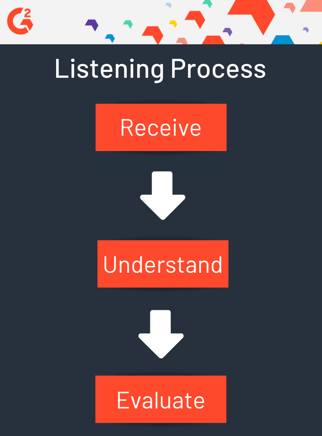

Did you hear that?
Maybe you heard it, but you weren’t exactly listening. We can hear things all day long without actually listening to them. It is perfectly fine to not give some sounds a second thought, such as chirping birds or car horns blaring in traffic. But when actively communicating, listening intently is key.
Communication theory tells us that the whole point of communicating is to circulate information. Being on the sender side of a communication model is fun and all, but gaining new insights is exclusive to the receiver side. And the only way to be an effective receiver is by listening.
While listening may seem like an involuntary act, the process has more steps than most people think.
Listening is giving your attention to sound and interpreting what you hear. The process involves initially hearing a sound, identifying it, and then processing its meaning.
Before we go on, it is important to note the difference between listening and hearing. They are similar concepts that are understandably confused.
Hearing is an effortless act that happens involuntarily. It is simply our senses perceiving a sound. Listening is choosing to hear something and focusing on it. Let’s check out an example when both are used.
Say there is maintenance work being done at your office, but you didn’t read the email giving you a heads up. You are minding your own business, working, and you hear a noise that sounds like a dentist tool. Because it was unintentional and you weren’t deliberately paying attention, your senses picking up on the noise is an example of hearing. However, after you heard it once and became curious, you started listening to the sound to identify it. You hear it again, and with the help of your focus and attention, you can interpret the sound and identify that it was a drill.

Hearing is technically a part of listening. Adding attention and interpretation just takes it a step further.
Listening is most commonly associated with verbal communication. We use our ears to listen to what other people are saying. However, the “paying attention” part of listening’s definition implies that it can occur in other types of messages as well.
Paying attention applies to all types of communication. When people speak, we listen by, you guessed it, listening. When people communicate nonverbally, we “listen” by focusing on their actions and interpreting what they mean. When presented with written communication, we “listen” by reading it intently.
Keep in mind that listening may be the act of paying attention to sound, but other types of communication include a variation of listening that is equally as important.
You will get nowhere in your personal or professional life if you cannot master listening. Harsh, I know. But I don’t make the rules.
New information is constantly being tossed around and if you aren’t paying attention, you might miss something that could affect you in the long run. Relationships, personal and professional, thrive on effective communication, and listening is a key factor.
Oddly enough, there is more than one way to listen. In fact, there are quite a few.
Discriminative listening is the most basic form of listening. Not too different from just hearing something, discriminative listening is simply understanding different sounds and differentiating them from one another. These skills are developed early in life and become more adept as we gain new experiences and are exposed to more sounds.
As babies with little to no language skills, discriminative listening is all we know. We understand that humans speaking and dogs barking are two different sounds. As adults, we use discriminative listening to determine emotion. Aspects of verbal communication, such as emphasis and tone, can give the listener an idea of the speaker’s current emotional state.
Comprehensive listening is understanding the message being communicated. After hearing the sounds and differentiating it from others that we have heard, we make sense of it.
In order to be a comprehensive listener, vocabulary and language skills are necessary. Not understanding the meaning of a word or the language of the speaker limits the listener.
Comprehensive listening also means paying attention to nonverbal cues. Comprehending someone’s actions is just as important as understanding their words as they both have an effect on the overall message.
Using the word critical here doesn’t necessarily mean the words will be scrutinized. Critical listening is used when we comprehend someone’s words and then evaluate them to either solve a problem or make a decision. It includes analyzing the information being presented and then aligning them with our current knowledge, values, and beliefs.
Dialogic listening is used when a conversation is regularly flowing back and forth between two people. It adds the element of curiosity to listening. Listeners seek new information about the person they are speaking with and the subject they are discussing.
Dialogic listening is also referred to as relational listening. The exchanging of information can cause the speakers to relate to one another, resulting in a connection.
The digital age has brought about a new form of listening. Social listening is keeping an eye on digital conversations and information. This can apply to individuals, businesses or entire industries.
Social listening can sometimes be similar to dialogic listening. When social media users are saying things about a person, business or brand online, a response might be expected. Paying attention to digital conversations that concern you and responding when necessary gives you a voice on public platforms.
While most types of listening allow people to access new information and ideas, unproductive types of listening still exist. Biased listening occurs when someone hears only what they want based on bias and prejudice. Yes, the listener can still gain new information, but biased listening can also lead to misinterpreting the speaker’s message.
Hearing words is easy, but actively listening requires more effort. Distractions, lack of interest, and being bombarded with multiple conversations at once all stand in the way of being an effective listener. Here are some skills to step up your listening game.
This should be an obvious one, but make sure you are actively listening instead of just hearing words. Show your interest by sitting up straight and making eye contact with the speaker.
First of all, it’s rude. Also, it proves to the speaker that you were focused on what you wanted to say, instead of what they were saying to you. Constantly interrupting someone implies a boatload of negative qualities in a person, and you don’t want to make the wrong impression.
Asking questions is a great indicator that you are paying attention, but only if the questions are asked to clarify something that was already touched on. Asking unrelated questions can distract from the original purpose of the conversation, and unimportant information will replace the knowledge you need.
Put yourself in the speaker’s shoes. If they are talking about something exciting, look excited. If it is a sad topic, don’t sit there smiling from ear to ear. Identify what the speaker is feeling and do your best to match it.
The information being presented to you may be foreign and unfamiliar. Keep the negative criticism to a minimum. Once you go down that mental road, it’s hard to turn around.
All positive relationships are fueled by effective communication. When communicating, listening to information is just as important as providing it. Strengthening your listening skills will make you an active and valuable member of any conversation.
Want to learn more about how to show people you are interested and listening? Check out our resource on nonverbal communication for tips!
Mary Clare Novak is a Content Marketing Specialist at G2 based in Burlington, Vermont, where she is currently exploring topics related to sales and customer relationship management. In her free time, you can find her doing a crossword puzzle, listening to cover bands, or eating fish tacos. (she/her/hers)
If you're in a creative business and have ever created content, you know how important it is....
 by Slavica Grgic
by Slavica Grgic
Podcasts have become an essential element of the digital landscape — and you should be a part...
 by Piper Thomson
by Piper Thomson
In a crowded online market, it's hard to stand out as a business. But with social listening...
 by Alicja Mękarska
by Alicja Mękarska
If you're in a creative business and have ever created content, you know how important it is....
 by Slavica Grgic
by Slavica Grgic
Podcasts have become an essential element of the digital landscape — and you should be a part...
 by Piper Thomson
by Piper Thomson
Never miss a post.
Subscribe to keep your fingers on the tech pulse.



